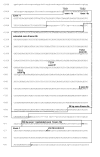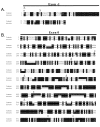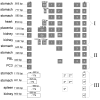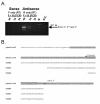Revised genomic structure of the human ghrelin gene and identification of novel exons, alternative splice variants and natural antisense transcripts
- PMID: 17727735
- PMCID: PMC2014779
- DOI: 10.1186/1471-2164-8-298
Revised genomic structure of the human ghrelin gene and identification of novel exons, alternative splice variants and natural antisense transcripts
Abstract
Background: Ghrelin is a multifunctional peptide hormone expressed in a range of normal tissues and pathologies. It has been reported that the human ghrelin gene consists of five exons which span 5 kb of genomic DNA on chromosome 3 and includes a 20 bp non-coding first exon (20 bp exon 0). The availability of bioinformatic tools enabling comparative analysis and the finalisation of the human genome prompted us to re-examine the genomic structure of the ghrelin locus.
Results: We have demonstrated the presence of an additional novel exon (exon -1) and 5' extensions to exon 0 and 1 using comparative in silico analysis and have demonstrated their existence experimentally using RT-PCR and 5' RACE. A revised exon-intron structure demonstrates that the human ghrelin gene spans 7.2 kb and consists of six rather than five exons. Several ghrelin gene-derived splice forms were detected in a range of human tissues and cell lines. We have demonstrated ghrelin gene-derived mRNA transcripts that do not code for ghrelin, but instead may encode the C-terminal region of full-length preproghrelin (C-ghrelin, which contains the coding region for obestatin) and a transcript encoding obestatin-only. Splice variants that differed in their 5' untranslated regions were also found, suggesting a role of these regions in the post-transcriptional regulation of preproghrelin translation. Finally, several natural antisense transcripts, termed ghrelinOS (ghrelin opposite strand) transcripts, were demonstrated via orientation-specific RT-PCR, 5' RACE and in silico analysis of ESTs and cloned amplicons.
Conclusion: The sense and antisense alternative transcripts demonstrated in this study may function as non-coding regulatory RNA, or code for novel protein isoforms. This is the first demonstration of putative obestatin and C-ghrelin specific transcripts and these findings suggest that these ghrelin gene-derived peptides may also be produced independently of preproghrelin. This study reveals several novel aspects of the ghrelin gene and suggests that the ghrelin locus is far more complex than previously recognised.
Figures








Similar articles
-
Complex organisation and structure of the ghrelin antisense strand gene GHRLOS, a candidate non-coding RNA gene.BMC Mol Biol. 2008 Oct 28;9:95. doi: 10.1186/1471-2199-9-95. BMC Mol Biol. 2008. PMID: 18954468 Free PMC article.
-
[Analysis, identification and correction of some errors of model refseqs appeared in NCBI Human Gene Database by in silico cloning and experimental verification of novel human genes].Yi Chuan Xue Bao. 2004 May;31(5):431-43. Yi Chuan Xue Bao. 2004. PMID: 15478601 Chinese.
-
Ghrelin gene-related peptides: multifunctional endocrine / autocrine modulators in health and disease.Clin Exp Pharmacol Physiol. 2010 Jan;37(1):125-31. doi: 10.1111/j.1440-1681.2009.05241.x. Epub 2009 Jun 29. Clin Exp Pharmacol Physiol. 2010. PMID: 19566830
-
New insights into the molecular complexity of the ghrelin gene locus.Cytokine Growth Factor Rev. 2009 Aug;20(4):297-304. doi: 10.1016/j.cytogfr.2009.07.006. Epub 2009 Aug 8. Cytokine Growth Factor Rev. 2009. PMID: 19665916 Review.
-
One ancestor, several peptides post-translational modifications of preproghrelin generate several peptides with antithetical effects.Mol Cell Endocrinol. 2006 Aug 15;256(1-2):1-8. doi: 10.1016/j.mce.2006.05.007. Epub 2006 Jul 7. Mol Cell Endocrinol. 2006. PMID: 16828223 Review.
Cited by
-
Role of the Ghrelin System in Colorectal Cancer.Int J Mol Sci. 2022 May 11;23(10):5380. doi: 10.3390/ijms23105380. Int J Mol Sci. 2022. PMID: 35628187 Free PMC article. Review.
-
Complex organisation and structure of the ghrelin antisense strand gene GHRLOS, a candidate non-coding RNA gene.BMC Mol Biol. 2008 Oct 28;9:95. doi: 10.1186/1471-2199-9-95. BMC Mol Biol. 2008. PMID: 18954468 Free PMC article.
-
Ghrelin as an Anti-Sepsis Peptide: Review.Front Immunol. 2021 Jan 28;11:610363. doi: 10.3389/fimmu.2020.610363. eCollection 2020. Front Immunol. 2021. PMID: 33584688 Free PMC article. Review.
-
Role of SST, CORT and ghrelin and its receptors at the endocrine pancreas.Front Endocrinol (Lausanne). 2012 Sep 18;3:114. doi: 10.3389/fendo.2012.00114. eCollection 2012. Front Endocrinol (Lausanne). 2012. PMID: 23162532 Free PMC article.
-
Potential Therapeutic Effects of Gut Hormones, Ghrelin and Obestatin in Oral Mucositis.Int J Mol Sci. 2019 Mar 27;20(7):1534. doi: 10.3390/ijms20071534. Int J Mol Sci. 2019. PMID: 30934722 Free PMC article. Review.
References
-
- Tritos NA, Kokkotou EG. The physiology and potential clinical applications of ghrelin, a novel peptide hormone. Mayo Clin Proc. 2006;81:653–660. - PubMed
-
- Jeffery PL, Murray RE, Yeh AH, McNamara JF, Duncan RP, Francis GD, Herington AC, Chopin LK. Expression and function of the ghrelin axis, including a novel preproghrelin isoform, in human breast cancer tissues and cell lines. Endocr Relat Cancer. 2005;12:839–850. doi: 10.1677/erc.1.00984. - DOI - PubMed
Publication types
MeSH terms
Substances
LinkOut - more resources
Full Text Sources
Other Literature Sources
Molecular Biology Databases

